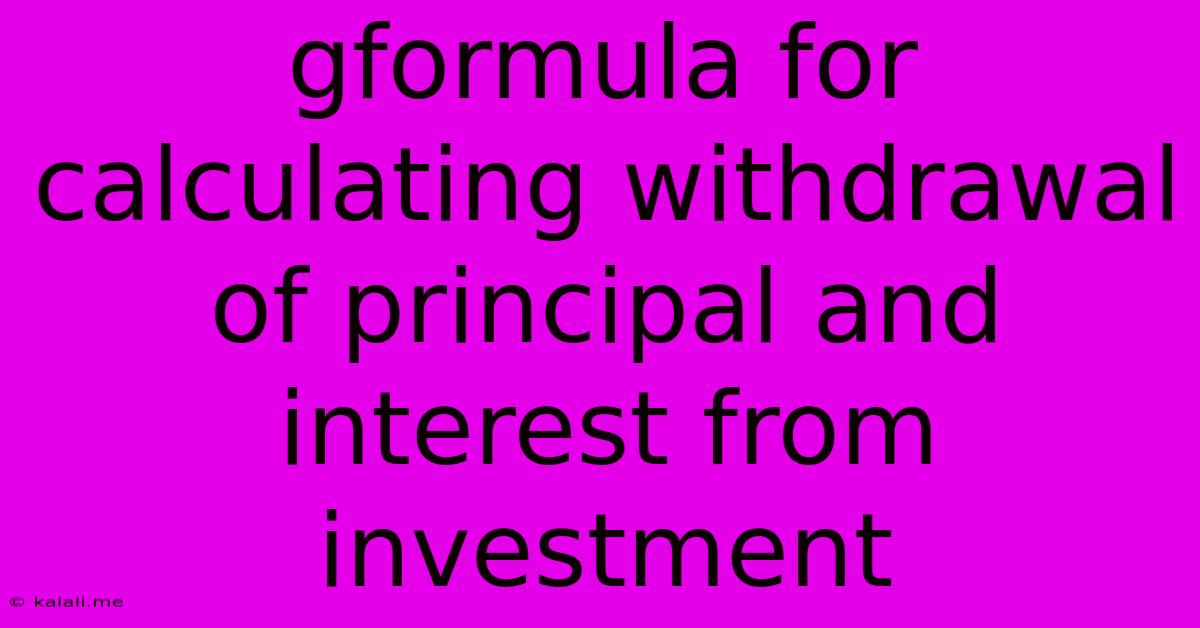Gformula For Calculating Withdrawal Of Principal And Interest From Investment
Kalali
May 24, 2025 · 3 min read

Table of Contents
Understanding the G-Formula for Calculating Investment Withdrawals
Are you planning to withdraw both principal and interest from your investments over a specific period? Understanding how to calculate the sustainable withdrawal amount is crucial for ensuring your retirement funds last. This article delves into the G-formula, a powerful tool for determining safe withdrawal rates while accounting for both principal and interest. This method helps you avoid depleting your investment prematurely.
The G-formula, also known as the Gordon Growth Model, is a mathematical model primarily used to value stocks, but its underlying principles can be adapted for retirement withdrawal planning. It helps you calculate a consistent withdrawal amount that accounts for investment growth and ensures your capital doesn't dwindle too quickly. This is particularly important during periods of market volatility.
What is the G-Formula?
The basic G-formula is expressed as:
Withdrawal Rate = (Initial Investment * (Growth Rate - Inflation Rate)) / (1 + Growth Rate)
Where:
- Initial Investment: The total amount of your investment at the beginning of the withdrawal period.
- Growth Rate: The expected annual return on your investment (before inflation). This is a crucial factor and should be based on realistic expectations, considering historical performance and your investment strategy's risk profile. A conservative estimate is recommended.
- Inflation Rate: The expected annual rate of inflation. This adjusts the withdrawal for the decreasing purchasing power of money over time.
How to Use the G-Formula for Retirement Withdrawal Planning
Let's illustrate the G-formula's application with an example:
Suppose you have an initial investment of $1,000,000, expect an average annual growth rate of 5%, and anticipate an inflation rate of 2%.
Applying the G-formula:
Withdrawal Rate = ($1,000,000 * (0.05 - 0.02)) / (1 + 0.05) Withdrawal Rate = ($1,000,000 * 0.03) / 1.05 Withdrawal Rate = $30,000 / 1.05 Withdrawal Rate ≈ $28,571.43
This means you can withdraw approximately $28,571.43 annually while maintaining your principal and keeping pace with inflation. It’s important to note that this is a simplified calculation, and the actual withdrawal amount may vary depending on the investment performance in any given year.
Important Considerations and Limitations
While the G-formula provides a valuable framework, it’s crucial to consider its limitations:
- Variable Growth Rates: The formula assumes a constant growth rate, which is unrealistic in the volatile world of investments. Market fluctuations can significantly impact the withdrawal amount's sustainability.
- Inflation Variability: Similarly, inflation rates are not constant. Unexpected inflationary pressures can erode purchasing power and jeopardize the withdrawal plan.
- Tax Implications: The formula doesn't account for taxes on investment returns or withdrawals. Tax liabilities can considerably reduce the available funds.
- Sequence of Returns Risk: Poor returns early in the withdrawal phase can severely deplete the principal, even if later returns are positive. This emphasizes the importance of a conservative growth rate estimate.
- Unexpected Expenses: The formula doesn’t consider unforeseen expenses, such as medical emergencies. Building a contingency fund is crucial.
Beyond the Basic G-Formula: A More Holistic Approach
The basic G-formula provides a starting point, but for a comprehensive retirement withdrawal strategy, consider incorporating these additional factors:
- Monte Carlo Simulations: These simulations model various market scenarios to assess the probability of your plan succeeding.
- Portfolio Diversification: Diversifying investments across different asset classes can reduce risk and improve the chances of consistent returns.
- Regular Review and Adjustment: Regularly review your withdrawal plan, adjusting it as necessary based on market conditions, inflation, and your changing circumstances.
The G-formula is a valuable tool for understanding the principles of sustainable withdrawals, but it shouldn't be the sole basis for making financial decisions. Consult a qualified financial advisor for personalized guidance tailored to your specific circumstances and risk tolerance. They can help you develop a robust retirement plan that protects your assets and ensures your financial security throughout retirement.
Latest Posts
Latest Posts
-
How To Remove Carpet Glue From Concrete
May 24, 2025
-
The Book Of The Acts Of Solomon
May 24, 2025
-
How To Get Sponge In Minecraft
May 24, 2025
-
How Long Is A Generation In The Bible
May 24, 2025
-
How To Get Rid Of Water In Minecraft
May 24, 2025
Related Post
Thank you for visiting our website which covers about Gformula For Calculating Withdrawal Of Principal And Interest From Investment . We hope the information provided has been useful to you. Feel free to contact us if you have any questions or need further assistance. See you next time and don't miss to bookmark.